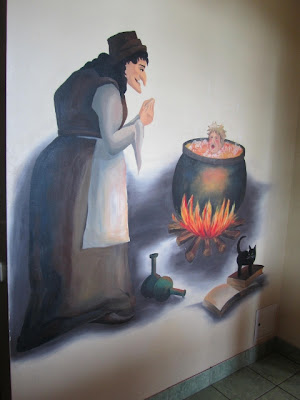Riga with a poplulation of about 600 000 is the capital of Latvia - the second of the Baltic states we have visited. Latvia is much bigger than Estonia, its northern neighbour. Our trip from Tallinn to Riga followed the coast for much of the journey.
We stopped at a resort town of Parnu for morning tea and a walk on the beach. The beach had no waves and the water was quite shallow, but it is obviously a popular holiday spot with the locals.
 |
| David testing the waters |
We passed through the border between Estonia and Latvia which is no longer staffed since all the Baltic states are now part of the European Union.
 |
The border between Estonia and Latvia
|
After passing whrough some fairly unremarkable rural countryside we stopped for lunch at the village of Ragana, at an eatery called Ragana's Kekis. I think kekis is the latvian word for witch, and the whole place was decorated according to this theme, including the wall painting below.
Next we visited Taurida National Park, one of Latvia's popular parks, and in winter a popular ski area. The park features many sculptures, the most significant recognising the person who made it his life's work to record thousands of Latvian folk songs for posterity.
 |
Tony next to the statue
|
The park also contains the ruins of Taurida Castle, which was built on a high strategic position with views over the river valley. David climbed the 300+ steps to the top of the tower for an excellent view.
 |
Taurida Castle
|
In the evening we attended a dinner with a folk performance from a group of Latvian entertainers. A fun night.
 |
Entertainers in traditional costumes
|
The next morning we had a tour of the city, including the old medieval town, much of which is decorated in the art nouveau style. The old town has narrow winding streets, stone paving, an interesting mix of private and state owned properties, a few churches, and the usual mix of cafes and souvenir shops. Some pictures of the old town below.
 |
| Crazy mix of archtectural styles |
 |
| Narrow winding streets |
 |
| The cloister of the very old Dome Church |
 |
| Decorative features on a public building |
The modern town has several distinguishing features as well.There is very little high rise yet. Also, there are many trees and a green belt in Riga, separating the old and new towns. Coming out of the Soviet era much has to be done to restore many of the buildings but progress has been made.
 |
| The freedom monument |
 |
| The Russian Orthodox Church. During the soviet period its interiors were stripped and it was turned into a planetarium. It has been restored to its former glory. |
 |
| One of Riga's many bridges |
 |
| This ugly edifice is known as Stalin's birthday cake |














I enjoyed this very much. No litter around that I can see all looks very tidy.
ReplyDelete